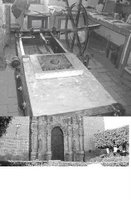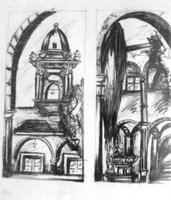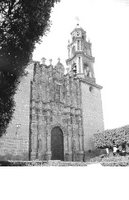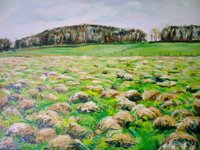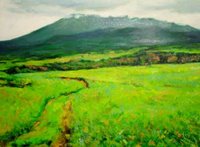
Sogetsu Ikebana
Spring Breeze Ikebana Exhibit
April 22 – 23, 2006
Ikebana Artists:
Mayumi & Jennifer Shepherd
Spring Breeze Exhibit PhotosSPRING BREEZE: Exhibit Statement
By Jennifer Shepherd
My Mother and I thought the title “Spring Breeze” would suit our exhibition very well since it has many meanings for us. First, it shows how we are looking forward to spring and it reminds people that it is just around the corner. We also want to show that a spring breeze brings with it changes in the flower materials and vases we utilize.
We are transitioning from the sombre mood of winter to the cheerful, bright colours of spring, with some cool colours to represent the breeze. Finally, we want to project a whole new frame of mind. While winter was here, no flowers were growing. Now, everything is starting to wake-up and come alive again.
I am using a modern technique to convey my perception of spring. My mother, Mayumi Shepherd, is expressing her thoughts through a more typical Ikebana-style arrangement. Through our arrangements, we hope you will capture our feeling of “Spring Breeze”.
At this time, my Mother and I would like to express our appreciation to Ms. Rebecca Benoit for inviting us to display this Ikebana exhibition. We are very delighted and honoured to take part on this occasion. This is our first Mother & Daughter exhibit and at the same time we are celebrating Sogetsu’s 80th Anniversary this year! Once again, we would like to thank Ms. Benoit for this wonderful opportunity.
Sogetsu History and Iemotos
Since the Sogetsu School was founded in 1927 by Sofu Teshigahara, a new age of ikebana was established under the leadership of brilliant and intelligent Iemotos. Sofu Teshigahara was called “Japan’s Picasso of Flowers”, he arranged dynamic and strikingly original works. Kasume Teshigahara created her own world of ikebana by delicate and also gorgeous flowers. Hiroshi Teshigahara pursued avant-garde expression through movies, installations and pottery.
The fourth Iemoto Akane Teshigahara who succeeds to the innovative spirit of successive Iemotos created many installations such as the open-air exhibition “Sogetsu Hana Avenue” in Omotesando, Tokyo, and brilliant installation on Noh stages. Her dynamic ikebana demonstrations are highly regarded by audiences both in Japan and overseas. At the same time she puts emphasis on teaching, and on the joy and wonder of creation. She continues challenging to create new possibilities of ikebana.
Sogetsu Ikebana
The Sogetsu ikebana has prepared four textbooks, both in Japanese and English, which are used throughout the world. According to the textbooks, students learn the basic arranging techniques for entering the creative world of ikebana.
As students improve, they can express their creativity using plant materials as they like. Sogetsu ikebana brings beauty of expression by plant materials and peace of mind in all of the spaces, in contemporary living; architectural spaces also shop windows, streets and stages.
The headquarters of Sogetsu Foundation are located in Tokyo and Osaka.
Sogetsu School has 49 branches in Japan and about 120 overseas branches/study groups in the world. Branches and study groups regularly hold workshops, demonstrations and exhibitions to enhance local cultural activities.
SOGETSU FOUNDATION
7-2-21 Akasaka, Minato-ku, Tokyo,
107-8505, Japan
Tel: 81-3-3408-1151
Fax: 81-3-3405-4947
http://www.sogetsu.or.jp
email: members[at]sogetsu.or.jp
Artist Biography: Jennifer Shepherd
Jennifer Shepherd is 14 years old. She commenced her Ikebana studies, when she was only 5 years old, with the current Iemoto Akane Teshigahara at Sogetsu HQ in Tokyo. She still travels to Japan each summer to continue her studies and participates in lessons with Sogetsu Master Teachers.
She participated twice in the Sogetsu H.Q. Exhibition at Nihonbashi Takashimaya Department store and also received an invitation to participate in an Exhibition at the Kaigakan organized by Ms. Suisen Takagi, Sogetsu H.Q. Master Teacher.
TV Asahi, a major TV company broadcast nationally a 30-minute program about Jennifer Shepherd, a young Ikebanist. Ottawa Centennial Chapter No. 120 of Ikebana International invited Jennifer to participate in the 2003 Annual Exhibition, both as an exhibitor and as an assistant in family workshops.
Jennifer is currently the youngest member of Sogetsu Ottawa Branch and has participated each year in the Sogetsu Ottawa Branch Annual Exhibition at the Embassy of Japan. She created a special, large stage arrangement for the 17th Annual Japanese Speech Contest at the Embassy of Japan.
Artist Biography: Mayumi Shepherd
Mayumi Shepherd earned her Ikebana licenses at Sogetsu Headquarters in Tokyo. While in Tokyo, she studied under a number of Headquarters Master Teachers including Senso Onaka, Suisen Takagi, Koka Fukushima and Bisen Sumide. She was also privileged to study under the current Sogetsu Iemoto, Akane Teshigahara. She still travels regularly to Tokyo to continue her studies and participate in teachers’ courses and seminars at Sogetsu H.Q.
After moving to Ottawa in August, 2002, Mayumi joined Sogetsu Ottawa Branch. Since April, 2003, she has been a Board member of Sogetsu Ottawa Branch and currently holds the title of Director.
Mayumi is also an active member of Ottawa Centennial Chapter No. 120 Ikebana International. In 2004-2005, she was a Board member, serving as Demonstration Chairperson and Co-Chairperson of Fundraising.
As an active member of the local Ikebana community, Mayumi has participated in over 30 Workshops, Exhibitions and Presentations in the Ottawa area and right across North America.
Mayumi also teaches privately and has been conducting lectures and workshops in Ottawa since 2002.
If you are interested in learning more about Ikebana, please contact Mayumi for information regarding presentations or lessons.
Mayumi "Suishin" Shepherd
Email: mayumi[at]shepherd.name
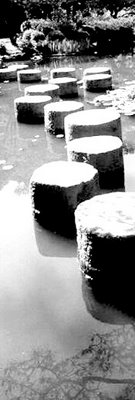 September 2006: (Saturday and Sunday, September 9th - 10th).
September 2006: (Saturday and Sunday, September 9th - 10th).